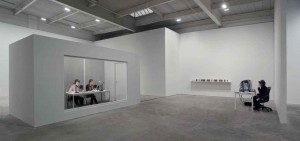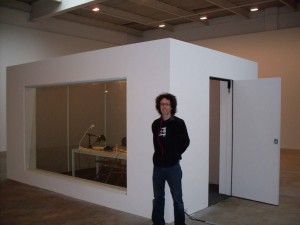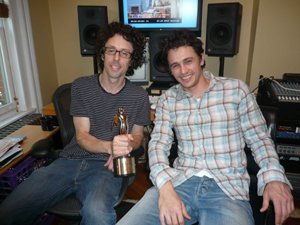Brooklyn Sound Society: High Art, Creatively Connecting and 2wice at Sundance
CLINTON HILL, BROOKLYN: This ‘hood is better known as “Crooklyn”, but resident Neil Benezra is only a thief of hearts. The founder of Brooklyn Sound Society, he charms the pants off his film/TV mix, art installation and 5.1 surround clients by being advanced, involved and efficient.
With two films he worked on in Sundance this year, we thought Neil was oh-so-apropo to learn a ton of really valuable information from.

Brooklyn Sound Society at On Kawara's Million Years at the David Zwirmer Gallery
Q: (Said like Navin Johnson) Who is Neil Benezra? What came before Brooklyn Sound Society?
A: I started out as a drummer in NYC rock and experimental bands and played with a wide range of musicians—everything from making a record with Joey Ramone—you can read all about this in the new book I Slept With Joey Ramone written by Mickey Leigh — to performing and recording with sound artist Stephen Viteillo, and playing percussion and making a record with the band Sulfur that included the brilliant Swans guitarist Norman Westberg. Along the way, I started playing a few other instruments and writing some music and doing sound design for theater.
Q: Nice start. From there, what led to Brooklyn Sound Society being born?
A: It was a combination of a few roads that led me to starting BSS. After spending a few years working as an art installer, and also as a result of being in the right place at the right time, I was asked to work on different sound projects for museums, galleries, and theater.
Fortunately this led to working with some really incredible artists, including Richard Foreman, and Joan Jonas, among others, sometimes becoming part of their creative process, which became for me the most valuable part of the job.
One highlight was working on-and-off for eight years with the avant-garde theater director Richard Foreman. It began by assisting him in his NYC theater on his sound design and making his ideas come to life with the occasional idea or mistake of mine getting thrown in. Then I went on to work on the sound for his international tours and had the chance to work throughout Europe and Asia on making his vision translate to different-sized venues.
One week the show might have been in a four hundred seat black-box theater and the next week it might have moved to a 1000-seat, four-tier opera house; obviously this presented some serious challenges. The most valuable part of the job for me was helping him develop the sound design for each show over a three-month period. He is widely recognized as a ground-breaking artist and his ideas on sound are a big part of that reputation.
A few years later, I was asked to supervise the building of an audio post production studio in NYC called Splash Studios, and this is where I got involved in working on films. After the construction was finished I jumped at the chance to work as an editor and mixer on the first big wave of reality shows that hit the airwaves and whatever film work was available.

Neil Benezra
It was a real trial by fire, within the first year I had the chance to mix about 60 shows that went on air. This experience taught me all about the process as well as what is required to pass through the QC process at different networks including Discovery, HGTV, Nick etc.
Q: Nice timing. Dude. What about your approach makes Brooklyn Sound Society different or unique from other audio post providers?
A: Well this is the tricky part! In a sense, I don’t want to compete — but I do want to try to stand out — in one area which is creativity.
My approach from the beginning has been to take the extra time needed to commit to each project in this way and to become a creative partner and part of the team as opposed to watching the clock. I’m committed to watching the outcome.
A lot of times when filmmakers come to me they have put everything they have into their work emotionally and financially, and I appreciate this and try to give them 110%. I’m interested in working on great films with interesting people and it seems that having this attitude is starting to pay off as I see the quality of work keeps going up.
I should say however that this is not the approach to take if you are in it for quick money. Most of the jobs that I find I’m up for these days are in direct competition with much bigger facilities and I think that I offer something that is increasingly hard to find at these places, which is a one-on-one relationship with each person that I’m working with.
Q: It’s a service industry, I agree. Tell us about your technical setup. What’s your key hardware/software, and why? And tell us your secret weapon! IF YOU DARE.
A: For the time being at least my studio is an extremely well-equipped small studio, although I should point out that it is acoustically designed and has a fully isolated voiceover/foley/ADR room, unlike most smaller spaces.
I work in Pro Tools because I find it to be the most straightforward program for editing, and is so far the industry standard in film sound, and it is important that my files can transfer to other facilities if needed. My setup is a fully loaded Dual Mac G5 with a Digi 002 LE with the Complete Toolkit so that I have surround-mixing capabilities.
For monitoring, I use the JBL LSR series and find that they translate incredibly well to different playback situations.
I also use the Waves Gold Bundle and assorted noise reduction programs, which I think I have worked to the limit of their capabilities. I’m on the fence right now about buying a Cedar DNS system, which is what most Hollywood studios use, because the technology is changing so rapidly.
My assistant editors are working on a fully loaded Intel Imac with an Mbox and the DVToolkit, and when I travel I take an Intel Macbook Pro with the Mbox Micro.
My secret weapon would be twofold:
First, technically I have really taken the time to learn what can be done with noise reduction after a few years of editing and mixing about two hundred episodes of reality-based broadcast episodes which was an incredible training ground for working with bad sound!
My second secret weapon, and more important one, is that I think I’m pretty good at connecting on a creative level with people, and this is what it’s really about for me. My goal is for people to come to me for this reason above anything else.
Q: You get a lot of art installation projects. How did you get started in this niche? What are the unique demands of art installations, from an audio post perspective?
A: Working as an art installer put me in the place of being the only guy on the crew who knew anything about sound, so I would hang the speakers, make the last-minute recording and mix or whatever else came my way.
After a while, I started getting calls to do all sorts of interesting projects from working directly with an artist creating their next sound piece to cleaning up important archival works of sound and video art. Some of it has been installation-based, like the On Kawara show in 2009 where I designed a voice booth that was installed in the middle of a gallery for five weeks, during which I had an engineer record voice recordings five days a week for eight hours a day as part of the artist’s work.
The whole time the gallery was open for visitors to walk through and view the process. Ultimately the recordings will be made into a limited edition box set — a piece of art.
There are unique demands in working one-on-one with an artist, who might be very demanding, since each project is part of their life’s work and could be looked at for many years to come. It is also common for a project to evolve in relation to the space it is being presented in — it might be site-specific, which means that the environment can change at any given moment, and you need to be open to this possibility.
This is something that most audio people are not at all used to and it can throw them off. Audio perfection is not always the ultimate goal. Many times an artist’s aesthetic sensibility can overrule perfection and that’s more important than what is considered “good sound” to many. Having played music in all kinds of experimental situations has made me more in tune to this idea than some might be. I like to think of noise as just another color in the palate.
Environmentally in art spaces there are always different acoustical challenges as a result of the space being designed for looking at things rather than listening to things, so as a result you may have a lot of reflective surfaces to deal with or overlapping sounds between different works in the same show.
On the studio side of it—when creating something new with an artist the demands are not that much different than in film but having a real understanding of the work and the history that lead up to it is important. I fortunately think I went to art school in a kind of roundabout but possibly more exciting way by working on these projects, collaborating with artists and marrying into a family with three great visuals artists, so I like doing my homework. It didn’t hurt that I spent a few years studying architecture before finishing up with a music degree.
Q: Damn, you ARE perfect! Seriously, that’s why you’re on SonicScoop. Tell us about the challenging aspects of the Joan Jonas project — we’re especially interested in the 5.1 surround needs here.
A: We’ll I’ve worked with Joan on and off for many years, including work that was shown as part of the 2009 Venice Biennale and various museum and galleries worldwide, so I know what the demands are and what the outcome might be.
A few years back we worked on an installation that she had at the Yvon Lambert Gallery, which included a projected video of a live performance piece she had done in the past. At the time we only had a stereo recording to work with so there wasn’t much we could do with the ambiance of the sound besides setting up a few speakers to listen back on.
Recently she approached me with the request to sound edit and mix another video taken from a series of ten performances at Dia:Beacon, Dia Art Foundation’s museum in Beacon, New York. Fortunately the sound engineer Patrick Heilman had the foresight to place and record eight microphones throughout the space, some direct and some indirect.
The performance involved Joan Jonas herself, several actors and the incredible Blue Note recording artist composer and pianist Jason Moran. My initial reaction was to make only a stereo mix until I learned of the complexity of the sound and how many mics were recorded, then thinking back to the other gallery installation, I realized that this too could possibly end up someday in a gallery, so it would be fantastic to actually feel the presence of the original space when you listen back and watch it somewhere else. I proposed this to Joan and she liked the idea.
As far as 5.1 mixes go this one is pretty straightforward because we are working with sound that was in the space and trying to recreate the spatial qualities as opposed to flying SFX around the room as in a film. The most challenging part was that due to performance constraints the mics were not always placed in a way to pick up the sound directly so there are times when I need to grab what one person is saying off of another person’s mic that might be across the room. Another issue is that being a limited run in a museum space, again not the best location for sound recording. There is a lot of reverberant room sound, and in many places blown-out mics.
Q: OK, tell us a mix tip you’ve learned recently for sound-to-picture mixing.
A: This is a funny one because I learn it over and over again, just when I forget about it there it is. The best ideas are often happy accidents that happen when you’re really tired.
This happened to me on a sound design project last week where we thought we were completely finished and came back for one more quick listen. During the listen, we moved something around and accidentally hit on something that connected in a way with the visuals that the filmmaker had never imagined. After we finished he turned to me and said that not only did it add to the films sound, but that it incredibly added a storytelling element to the film that he never thought of and looks as if it were written into the script.
That’s the kind of thing that I really love and for all of the musicians out there that hit upon that same kind of thing at 3:00 in the morning after recording all night, you know what I’m talking about.
Q: Let’s talk about your borough of choice for a second. Why is Brooklyn in particular a good place for an audio post company to be operating in and expanding?
A: It’s not, it’s terrible, stay out of Brooklyn, this is my town! Only kidding, it’s a great place because it’s got a lot of really interesting people in it who want to change the world a little or maybe even a lot.
I’m always amazed at how many calls I get form people who live within a one-mile radius of me, but with the Internet there are no limitations, last year I collaborated on a feature film with a filmmaker in California without ever meeting him until he came to NY a year later for a film festival screening of the same film. We have since hit it off and are working toward a second project. In the past few years I’ve gotten calls from as far away as India, Ireland and Australia.

Neil Benezra and James Franco
Q: What’s next for this crazy audio post biz? What mindset does someone need to survive and thrive in audio post moving forward?
A: Hold on one second, I have to get out my crystal ball! Seriously, I think the world of post is going to change pretty fast and the Internet is gong to open up a lot of opportunities in terms of streaming and getting everything big and small to your house or office on demand. I have also recently seen the light as far as online social networking goes and think that this is really important to be a part of. Here’s a perfect opportunity for a shameless plug, so here it is! Join my new Brooklyn Sound Society Facebook fan page to learn a few sound design tricks.
Q: OK, we WILL. Anything else?
A: Yes, this past year I was invited to create my own sound installation in Prenning Austria called Koln Kaddish which you can check out on my website. It was a big success and I have been invited back this year to work on two more.
Some other big news- I worked on two films which made it into Sundance this year and both are heavy on sound design, James Franco’s Herbert White and Bobby Miller’s Tub. Brooklyn Sound Society also recently won a Telly Award for sound design for James Franco’s film The Feast of Stephen.
S: Congrats, Neil Benezra! Keep up the BUENO WORK. – David Weiss







Adam Johnson
January 24, 2010 at 1:12 am (15 years ago)Cool post, anyone doing 5.1 or interested in 5.1 should check out the rad new cutting-edge and completely unique 3D mixing software called VibeStation by VRSonic.
Sound elements can be mixed in 3 dimensions, including above and below the listener (obviously), the ease of use and the spatial possibilities crush traditional 5.1, I beta-tested it for VRsonic at AES this year. this software will BLOW YOUR MIND! … ahem, seriously, and I’m not getting paid to say this, I truly believe it
http://www.vrsonic.com/products/vibestation.html
Adam Johnson
January 23, 2010 at 6:12 pm (15 years ago)Cool post, anyone doing 5.1 or interested in 5.1 should check out the rad new cutting-edge and completely unique 3D mixing software called VibeStation by VRSonic.
Sound elements can be mixed in 3 dimensions, including above and below the listener (obviously), the ease of use and the spatial possibilities crush traditional 5.1, I beta-tested it for VRsonic at AES this year. this software will BLOW YOUR MIND! … ahem, seriously, and I’m not getting paid to say this, I truly believe it
http://www.vrsonic.com/products/vibestation.html